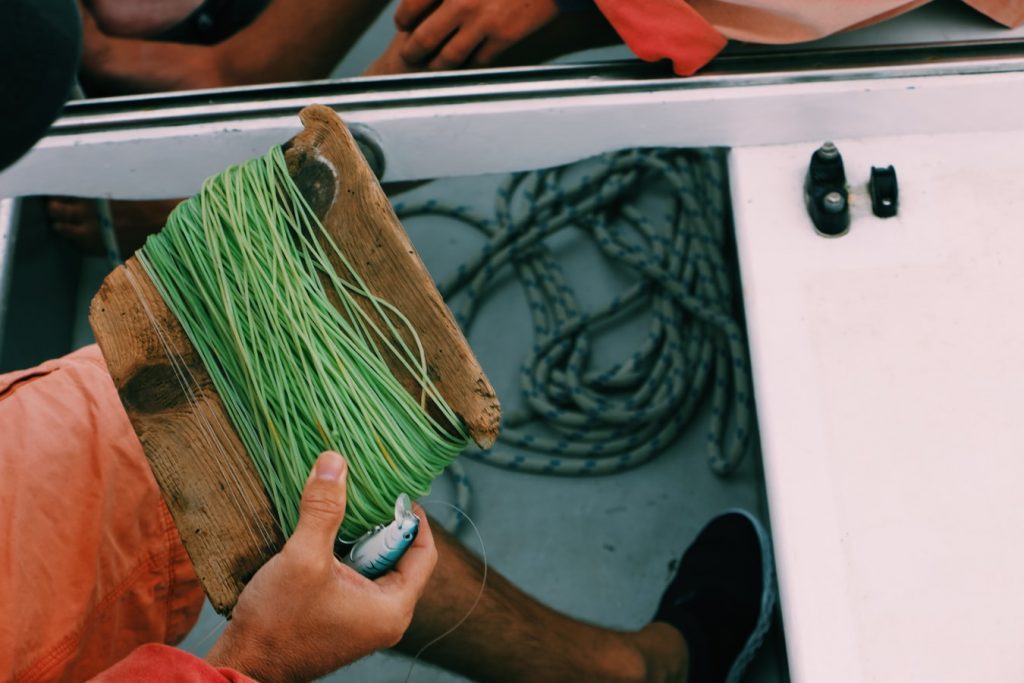Over time, the fishing line would be worn out, more easily entangled, and more difficult to capture. Spooling a new line is the same no matter what kind of rod you’ve got. All you have to do is knot the line and loop it around the spool of the reel. You’ll need various types of line to get the best cast possible for fly fishing. To catch a lot of fish, replace your line at least once a season. Do you know how to put new line on a fishing pole?
How To Put New Line On A Fishing Pole

A spinning reel is one of the most versatile types of fishing reels available and is extremely simple to use compared to a baitcasting reel. There is one thing, however. With spinning gear, it’s easy to add line twists when you’re spooling a reel. We’re going to make sure you know how to avoid the issue.
If your line is worn out and you need to restrain your fishing reel, you’ve got a wrong size line spooled up, and you want to change the fishing line, or you’ve just got a new spinning reel, in this post, we’ll clarify how to put a new line on your reel. In the end, you’ll see that it’s easy to spool a reel!
If you are spooling a medium-sized spinning reel and your fishing style is asking for something greater than a 12-pound test, you can use the braid. If you plan to go with a braid, first put a little mono on the spool as a backup (using the same steps discussed here). That’s going to keep the braid from slipping on the spool. With the backrest in place, you can tie the braid to the mono using the Uni Knot and then spool up as mentioned below.
How To Put New Line On A Fishing Pole: The Steps
This section gives you step-by-step instructions on how to position a line on a reel. Learn how to do it by continuing the article!
It can help to have another person around, but ultimately, you’re going to have to do this alone, so we’ve concentrated on taking measures to load the line on the spinning reel by yourself.
phase 1: connect the rod to the reel.
It is much simpler to mount a fishing line on a spinning reel if the reel is connected to the rod.
phase 2: use the first guide to run the sequence.
Take the end of the line off the spool on which it was put and run the line (towards the reel) through the first guide — the wide one that is positioned nearest to the seat of the reel.
phase 3: open your dance.
You’ve got to remember to unlock the bail. You’d be shocked how much this move is missed by people. Then, after the line is carefully tied to the spool, they realize it won’t be picked up by the bail, and it’s back to this step. Save yourself some trouble, and remember to open the bail right before you tie the line to the spool.
phase 4: connect the reel spool thread.
Learning how to tie the line to the reel is pretty straight ahead. You can wrap the line around the reel spool two times, then tie it with an overhand knot. Close the end of the tag trim.
If you’re limiting your reel because the line on it is worn out, you might want to leave some of the old line on the reel as a backrest. If you do that, you can simply connect the old line to the new line using the Uni node. This tip will save you some money by relinquishing your reel, because it will take less of a fresh line to fill the spool.

phase 5: lately, start the winding line on the reel.
Now, you can turn the bail closed and start turning the handle slowly. When you crank, the spinning bail is going to lay a line on the reel spool in even wraps. Stop after a few cranks because it’s time for the most important step: to ensure that the line spool is in the right direction.
phase 6: watch the orientation of your spool.
There are three ways the line spool may be oriented, and only one of them is right. The other two are going to end in a line twist. First of all, don’t run the line straight off the spool like you might when spooling a bait caster. It’s going to have to come off with a face of the spool pointing at you.
When discussing how to place a line on a reel, others would discuss whether the line should be clockwise or clockwise. It’s as confusing to explain as it’s to recall, so here’s a little trick.
Stand up, keeping the rod parallel to the floor. Place the line spool in front of you, with the mark either facing you or facing the floor.
While you’re putting a little stress on the line (with your hand, between the reel and the first guide), start cranking the reel. After about ten cranks, watch the line right next to the spool on the floor and lower the rod to allow it to slacken.
This is the moment of truth, and you’re going to see one of two things. The loose line is going to lie on the floor in good, comfortable loops, or you’re going to see the loops twist on themselves into coils that don’t look comfortable at all. At that point, you want to see relaxed coils, and if you don’t, just flip the spool over and repeat the test.
When you can crank around ten times and then see loose, comfortable coils on the concrete, you’ve got it, and you can go ahead. There’s no need to unravel any line to fix the twists that got in there; they’re so far in the spool that it doesn’t matter.
phase 7: crank as long as the reel spool is complete.
Now, all you need to do is fill the reel with a thread. Standing up, facing the spool on the floor, keep the rod parallel, place a little tension on the line between the reel and the first guide, and begin to crank slowly. Pick up the pace and keep going until the line comes within 1/8 and 3/16 inches from the lip of the spool. You can then clip the rope, thread it through the rest of the rod guides, and tie it to the lure.
How To Put New Line On A Fishing Pole: When Do You Need To Replace

Each line has different specifications, and we’re going over each one, so you have a clear idea of when to replace the fishing line, depending on what you like to use. If you don’t want to miss one aspect of the equipment repair, removing the fishing line should be at the top of the list. The last thing you want on the water is a broken fish because of a bad line.
how to put new line on a fishing pole: when the monofilament fishing line is replaced
Monofilament line is a basic nylon polymer that degrades over time due to sun exposure and use. Monofilaments’ best quality to anglers is inexpensive, but it also stretches, which many anglers prefer when fighting light fish. It’s spooling properties are all right, but it holds a memory, so it won’t come as a surprise when casting. You’ll see large loops in the rows.
The major problem with monofilament is that it is more delicate than the other two main forms of fishing line on the market because of these properties. With its ability to stretch, you might be able to find the line weaker over time.
In addition, unless you take extreme care of your equipment, prolonged exposure to sunlight inevitably degrades nylon. Because of this, it is recommended that you change your monofilament line every season. Make this part of your early spring routine. Just before you hit the sea, make sure you’ve re-engineered a brand-new monofilament thread.
If you fish regularly several days a week, it may be even more effective to replace your line a few days a season. Use your best judgment, and make sure to check your nick line and stretch it every time you’re out.
how to put new line on a fishing pole: when the braided fishing line is replaced
Braided line is a stronger, more sustainable fishing line that is the most common form of fishing line on the market today. Here you can find our thoughts on the best-braided fishing line. The braided fishing line is usually made of two types of fiber, often multiple fibers each. The only real drawback to the braided line is that they have not yet created a transparent or almost transparent braided line.
But instead of fooling the fish with the type of line you’re using, many anglers are forced to tie the monofilament or fluorocarbon leader lines to the lure. But, with the advantages of the braided line being multiple, it’s worth it.
So when are you going to replace the braided line? Again, the individual situations vary, but it is fair to say that the braided line will last for two or more seasons on your reels because of its durability.
The only two things you pay attention to with a braided line when you use it are discoloration and friction. Over time, whatever color line you use will fade away from sunlight and daily wear. That, combined with friction along the line, typically easily visible, is a very good indicator of when to replace it.
Usually, two seasons is a safe bet, but if you fish harder than normal anglers, you may want to replace them once a year.
how to put new line on a fishing pole: when the fluorocarbon fishing line is replaced
The most recent major development in fishing line technology is the invention of the Fluorocarbon Fishing Line. This line is a polyvinylidene strand microfiber, which is most similar to the monofilament line but is thicker, more transparent, and more costly.
Fluorocarbon line is denser than water, has zero absorption of water, and is almost invisible underwater due to its light refraction properties, making it the perfect market leader. However, it has memory so it’s not the best form of line to spool on a casting reel.
Owing to its construction, the fluorocarbon line lasts longer than the monofilament. Some even say that fluorocarbons will last longer than the braided line.
Its surface strength is high enough to barely crack or get nicks in it. If you are using the fluorocarbon line, you can change your line every two years or more, depending on how hard you fish your equipment. As with all the lines, be sure to visually check before each outing to make sure you’re not going to have any unwanted breaks.
We’re moving through some of the best fluorocarbon lines on the market today, so check it out if you’re looking to add it to your arsenal.
The line of fishing is disposable. It’s a wearable (in the sense that it breaks down) object. Fishing line is not something that you can sustain and extend for years and years.
Final Words
We hope this article will give you all the details you need to place the reel’s fishing line properly. It should be remembered that you may use the same technique to position a fishing line on spin-cast reels. The steps provided above refer primarily to spinning reels, which are open face reels, but they are the same steps you take when you place a line on the closed face reels. Only remember to run the line through the hole in the face of the reel. Now that you know how to string a reel, you’re going to be able to re-spool any time you need to.


